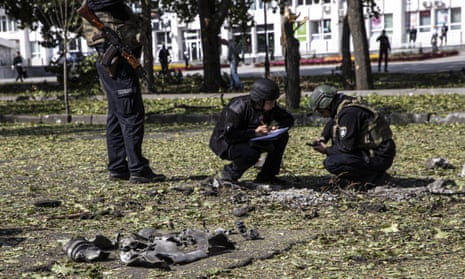A sudden, unexpected Ukrainian military success south-east of Kharkiv changes the analysis of Kyiv’s counterattack strategy. What had been expected to be a well-telegraphed effort to isolate the city of Kherson in the south has been turned on its head by the sudden pushback against Russian forces at the northern edge of the front.
The effort started on Tuesday, and by Wednesday the US Institute for the Study of War estimated that Ukraine’s forces had, in a surprise attack, advanced “at least 20km into Russian-held territory” recapturing approximately 400 sq km (154 sq miles) in an area scarcely focused on by military analysts until now.
According to one Russian military blogger, as highlighted by Rob Lee, a former US marine and military analyst, Ukrainian forces massed a “powerful tank fist” with 15 tanks to break through the occupiers lines. Cleverly, Kyiv had brought up its air defences in support, preventing Russian jets from immediately striking back to eradicate the gains, a sign of more sophisticated battlefield tactics.
The fighting is concentrated around the village of Balakliia, roughly 45 miles south-east of Kharkiv – which appears to still be held by the Russians, but which Ukraine hopes to surround – and in the vicinity of Shevchenkovo on the way to the Russian staging post of Kupiansk. The military aim is to increase pressure on Izium, a strategic city captured by the invaders at the end of April, a gateway to the western Donbas.
What will happen in the ensuing days is, as ever, hard to predict. But the assumption is that Ukraine has taken advantage of redeployments by Russia away from the north and east of the vast frontline to launch its surprise attack, making clear that it is willing to be flexible and opportunistic – and that anybody who is sure of Kyiv’s strategy should instead be willing to be surprised.
Contrast this to the Russian approach. Kremlin-directed forces are not used to thinking flexibly. When they have announced an offensive, as happened in spring, Moscow stuck to it, and for several months made slow but real gains in the eastern Donbas using the simple and grimly effective tactic of concentrating its artillery on a succession of cities, now Bakhmut.
In the past few weeks, though, the initiative has passed from Russia to Ukraine – a point clearly demonstrated by this week’s events south-east of Kharkiv. The medium-term strategic prize for Ukraine remains recapturing Kherson, because of its exposed position across the Dnieper River and because Russian-held bridges and river crossings resupplying the city appear easy to target.
Nevertheless, the progress near Kharkiv is significant, although it remains unclear if Ukraine can keep it up as autumn begins. Attackers usually sustain greater casualties. A Swedish volunteer in Ukraine described, in an Instagram posting, that only three soldiers from his platoon of 22 remain, with four killed in “one single shot” earlier this week from a tank grenade aimed at their bunker.
On the other hand, Ukrainian morale appears higher than for Russian counterparts as the war drags on into its seventh month. The country’s leaders are briefing allies they believe there is a short window up into November where their forces can show that they could push the Russians back – and do so much further again in a well-planned offensive in the spring.
